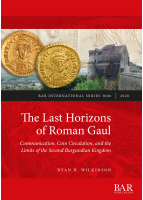Description
How did the ‘Fall of the Roman Empire’ change social and economic networks in eastern Gaul, and how did new ‘barbarian’ political frontiers shape those changes? Synthesising historical and archaeological approaches, this interdisciplinary study combines text-based prosopography with distribution analysis of ceramics and ‘pseudo-imperial’ coins in Burgundy and beyond. The study reveals that the frontiers of the second Burgundian kingdom (5th-6th centuries) curtailed traditional movements along one of Europe’s key riverine corridors and reshaped, temporarily, the mental geographies imagined by local Gallo-Romans, until Merovingian princes conquered the region. The book includes the most thorough assessment to date of the distribution of Burgundian coins found across France. Illuminating the Burgundian kingdom’s internal dynamics and its foreign relations, this assessment revises current understandings of the circulation of gold money across sixth-century Gaul, correcting over-generalisations that can obscure the importance of political frontiers at the end of antiquity.
AUTHOR
Ryan H. Wilkinson received a PhD in History from Harvard University; he is now Assistant Professor of History at Ambrose University in Calgary, Canada. His interdisciplinary research combines historical, archaeological, and numismatic approaches to the late antique world.
REVIEW
‘Wilkinson’s choice to embrace and explicate local variation provides a concrete example of the complex processes that lie behind the transition between antiquity and the Middle Ages.’ Jane Sancinito, Speculum, January 2023
‘The early Middle Ages are widely seen as a time of collapse and compartmentalisation. This work offers a fresh and engaging examination of which connections prevailed and why. It represents a significant corrective to narratives of involution, and demonstrates the value of juxtaposing diverse materials and methodologies.’ Dr Rory Naismith, University of Cambridge











